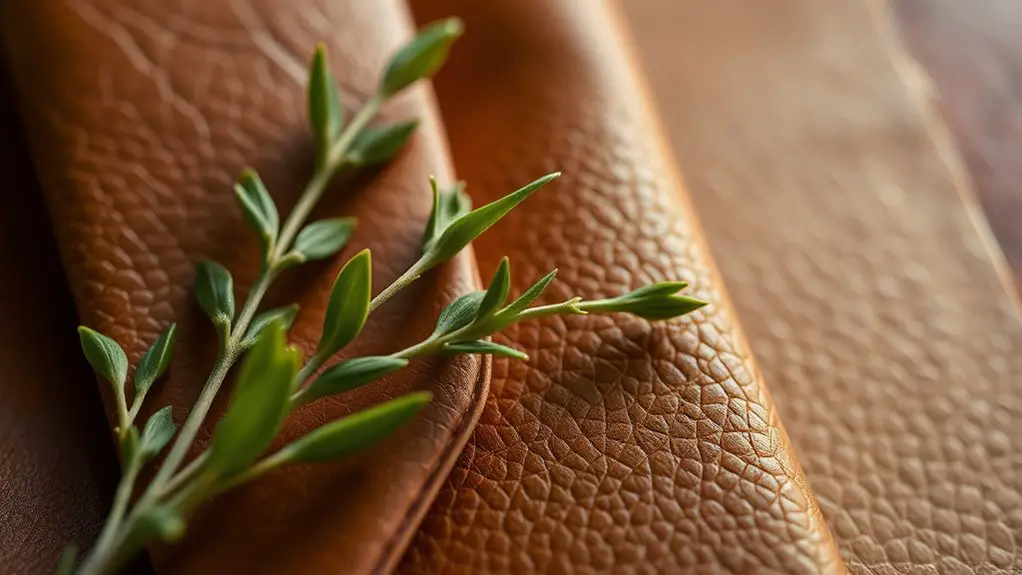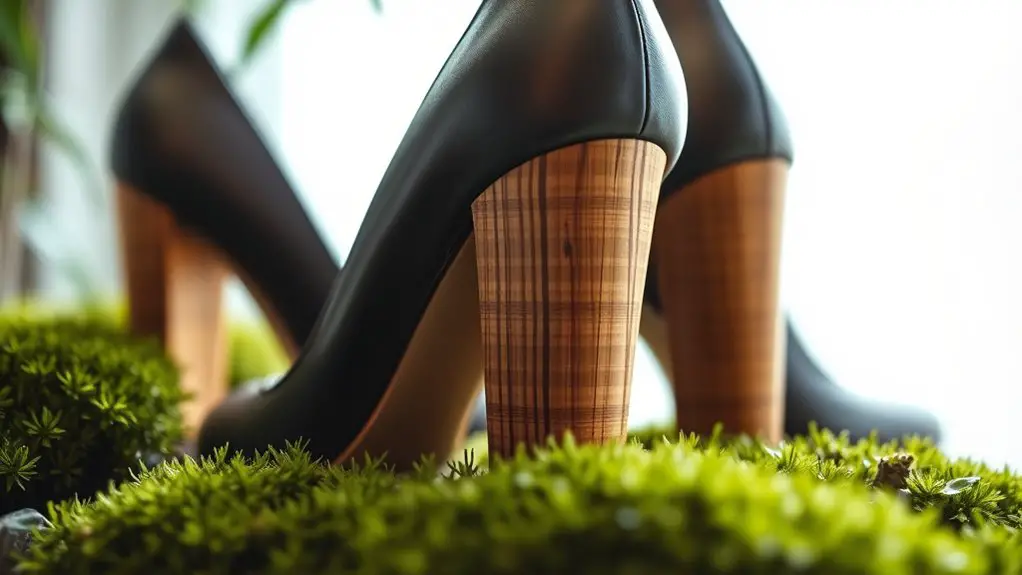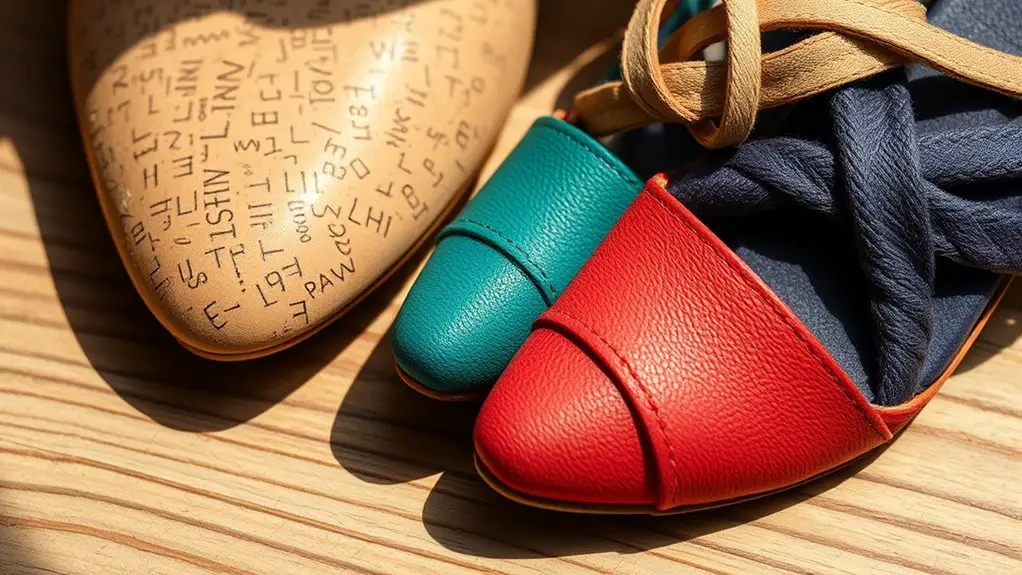When it comes to sustainable heel manufacturing, you’ll find a variety of innovative materials. Plant-based leathers like Piñatex, made from pineapple leaves, offer style without the ethical concerns of animal products. Organic cotton and hemp are biodegradable, comfortable, and environmentally friendly. Recycled plastics minimize waste, while bamboo and cork are renewable resources with low environmental footprints. Natural rubber provides cushioning and durability. Curious about how these materials transform fashion while protecting the planet? There’s more to explore!
Plant-Based Leathers

As you explore the world of sustainable fashion, you might find that plant-based leathers are revolutionizing heel manufacturing. These innovative materials, made from sources like pineapple leaves, apple peels, or cork, represent a significant shift toward sustainable sourcing in the footwear industry. By opting for plant-based leathers, you’re not only reducing reliance on animal products but also minimizing the environmental impact associated with traditional leather production.
The benefits of these plant materials go beyond eco-friendliness; they often require less water and energy during production. With their durability and unique textures, plant-based leathers offer style without compromising your values. They provide the perfect blend of fashion and sustainability, ensuring that your heels can look stunning while being kind to the planet. Embracing plant-based leathers is a step toward a more conscious wardrobe, aligning your choices with a healthier, greener future.
Recycled Plastics
When you consider recycled plastics in heel manufacturing, you’re looking at a game-changer for the environment. Not only do these materials greatly reduce waste, but innovative manufacturing processes also enhance their performance and durability. By choosing heels made from recycled plastics, you’re making a conscious decision that supports sustainability without sacrificing style.
Environmental Impact Reduction
While the fashion industry often faces scrutiny for its environmental footprint, the use of recycled plastics in heel manufacturing presents a compelling solution for reducing this impact. By incorporating recycled materials, you contribute to resource conservation and greatly lower the carbon footprint associated with new plastic production. This practice not only diverts waste from landfills but also supports a circular economy, encouraging sustainable consumption.
Here’s a quick comparison of the benefits of using recycled plastics:
| Benefit | Description |
|---|---|
| Resource Conservation | Reduces reliance on virgin materials |
| Carbon Footprint Reduction | Lowers emissions during production |
| Waste Reduction | Diverts plastic from landfills |
| Cost Efficiency | Often cheaper than new plastics |
| Consumer Awareness | Promotes eco-friendly choices |
Making informed choices in heel manufacturing can lead to a more sustainable future.
Manufacturing Process Innovations
Innovations in the manufacturing process of recycled plastics are transforming heel production, making it not just more efficient but also environmentally friendly. By implementing supply chain optimization, manufacturers are streamlining the sourcing and processing of recycled materials, reducing energy consumption and costs. You’ll find that waste reduction strategies play a vital role in this transformation—by reusing scraps and minimizing leftover materials, companies can lessen their environmental footprint. Advanced technologies, such as 3D printing and automated recycling systems, also contribute to a more sustainable approach, allowing for the creation of high-quality heels from post-consumer plastics. As you explore these innovations, it’s clear that the future of heel manufacturing is not just stylish but also responsible, paving the way for a greener fashion industry.
Performance and Durability Advantages
As you explore the world of recycled plastics in heel manufacturing, you’ll discover that these materials not only contribute to sustainability but also offer impressive performance and durability. By embracing sustainable innovation, brands are enhancing the way heels perform under pressure. Recycled plastics can withstand wear and tear, ensuring that your favorite pair lasts through countless outings. Their lightweight nature improves comfort without sacrificing strength, making them a smart choice for both style and function. Additionally, the material efficiency of recycled plastics reduces waste and energy consumption during production. So, when you choose heels made from these materials, you’re not just making a fashion statement—you’re supporting a more eco-conscious approach that prioritizes longevity and environmental responsibility.
Organic Cotton
Organic cotton is rapidly gaining recognition as a sustainable choice in heel manufacturing, thanks to its eco-friendly cultivation practices and biodegradable properties. By opting for organic cotton, you support organic farming methods that avoid harmful pesticides and synthetic fertilizers, promoting healthier soil and ecosystems. This process not only reduces environmental impact but also enhances the quality of the fibers used in sustainable textiles.
When you choose heels made from organic cotton, you’re not just investing in stylish footwear; you’re making a conscious decision that benefits the planet. Organic cotton is soft, breathable, and durable, making it ideal for creating comfortable and long-lasting heels. Plus, its biodegradable nature guarantees that when your shoes reach the end of their life, they won’t contribute to landfill waste. Embracing organic cotton in heel manufacturing is a step toward a greener future, allowing you to walk with both style and sustainability.
Bamboo

While many materials vie for the title of most sustainable, bamboo stands out in heel manufacturing for its rapid growth and minimal environmental impact. When you consider bamboo benefits, it’s hard not to be impressed. This versatile plant not only regenerates quickly but also improves soil health and absorbs carbon dioxide efficiently.
Here are some key points about bamboo sourcing:
- Fast Growth: Bamboo can grow up to 3 feet in a single day, making it a renewable resource.
- Low Water Usage: It requires considerably less water than traditional hardwoods.
- Pesticide-Free: Bamboo naturally resists pests, reducing the need for harmful chemicals.
- Biodegradable: Unlike synthetic materials, bamboo decomposes naturally, leaving little environmental footprint.
Cork
Cork is not just a trendy choice; it’s an eco-friendly material that boasts a sustainable production process. Its natural resilience and durability make it perfect for creating stylish yet long-lasting heels. Plus, cork’s versatility opens up a world of design possibilities, allowing you to step out in style while also caring for the planet.
Eco-Friendly Production Process
As you explore sustainable materials for heel manufacturing, you’ll find that cork stands out due to its eco-friendly production process. This natural material is not only stylish but also aligns with sustainable practices and ethical sourcing. Here are some key points about cork’s production:
- Harvesting: Cork is harvested from the bark of cork oak trees without harming them, allowing trees to continue growing.
- Renewable Resource: The cork bark regenerates every 9 years, making it a highly renewable resource.
- Low Energy Consumption: The production process requires minimal energy compared to synthetic materials.
- Biodegradable: At the end of its life cycle, cork naturally decomposes, reducing waste.
Natural Resilience and Durability
When considering materials for heel manufacturing, you’ll appreciate cork’s natural resilience and durability, which make it an excellent choice for sustainable fashion. Cork is a remarkable natural composite, harvested from the bark of cork oak trees without harming them. This sustainable sourcing guarantees that the ecosystem remains intact while providing a renewable resource. Its lightweight yet sturdy nature contributes to high-quality heels that stand the test of time, reducing the need for frequent replacements. Additionally, cork’s unique ability to withstand wear and tear means that your stylish footwear can maintain its integrity through various conditions. By choosing cork, you’re not just investing in durability; you’re also making an eco-conscious decision that supports both the planet and ethical manufacturing practices.
Versatile Design Applications
The remarkable properties of cork extend beyond durability, showcasing its versatility in design applications for heels. As you explore sustainable fashion, you’ll find cork is an excellent choice for various styles, thanks to its unique characteristics. Here are four design innovations that utilize cork effectively:
- Textured Surfaces: Cork can be embossed or patterned, allowing for creative visual appeal.
- Lightweight Construction: Its lightweight nature makes heels comfortable without sacrificing style.
- Color Variability: Cork can be dyed or treated, giving you a range of color options to match any outfit.
- Eco-Friendly Accents: Incorporating cork as an accent can elevate a design while promoting sustainability.
With cork, you’re not just stepping into fashion; you’re stepping into a more sustainable future.
Hemp
Hemp, a resilient and versatile plant, is making waves in the world of heel manufacturing due to its eco-friendly properties. You might be surprised to learn that hemp benefits extend beyond just strength; it’s also biodegradable and requires minimal water and pesticides to grow. This makes it an ideal candidate for sustainable fashion.
When you choose heels made from hemp, you’re not only opting for durability but also supporting hemp sustainability. Hemp fibers can be processed into a soft, breathable fabric that’s perfect for footwear, offering a unique combination of style and environmental consciousness.
Additionally, hemp cultivation helps improve soil health and capture carbon, further reducing its environmental footprint. By incorporating hemp into heel designs, manufacturers are paving the way for a more sustainable future in fashion. So, when you wear hemp-based heels, you’re making a statement that prioritizes both style and the planet.
Natural Rubber

Natural rubber is quickly emerging as a game-changer in heel manufacturing, thanks to its unique blend of sustainability and functionality. By choosing natural rubber, you’re not only making a stylish choice but also supporting eco-conscious practices through sustainable sourcing. Here are some natural benefits of this remarkable material:
- Biodegradability: Unlike synthetic materials, natural rubber breaks down naturally, reducing landfill waste.
- Flexibility and Comfort: It provides superior cushioning, making heels more comfortable for extended wear.
- Durability: With proper care, natural rubber heels can last, minimizing the need for frequent replacements.
- Eco-Friendly Production: Harvested from rubber trees, it requires less energy to process compared to petrochemical alternatives.
Reclaimed Wood
When you choose reclaimed wood for heel manufacturing, you’re not just opting for a unique aesthetic; you’re also contributing to a more sustainable future. This material is sourced from old buildings, furniture, and other structures, making it a prime example of sustainable sourcing. By repurposing wood that would otherwise end up as waste, you help reduce deforestation and promote eco-friendly practices.
Here’s a quick look at the benefits of using reclaimed wood in heel manufacturing:
| Benefit | Description | Impact |
|---|---|---|
| Sustainable Sourcing | Reduces need for new materials | Lowers deforestation |
| Unique Aesthetic | Each piece has its own history | Enhances design |
| Durability | Often higher quality than new wood | Longevity |
| Carbon Footprint | Less energy used in production | Reduces emissions |
Piñatex
Piñatex is revolutionizing the way we think about materials in heel manufacturing, offering a sustainable alternative to traditional leather. Made from the fibers of pineapple leaves, it’s an innovative solution that promotes piñatex sustainability while supporting local farming communities. Here’s why piñatex production is a game-changer:
- Eco-Friendly: Utilizing agricultural waste, piñatex reduces waste and promotes sustainability.
- Animal-Friendly: As a plant-based material, it eliminates the ethical concerns tied to animal leather.
- Durability: Piñatex is strong and versatile, making it perfect for stylish, long-lasting heels.
- Biodegradable: Unlike synthetic materials, piñatex can decompose, minimizing environmental impact.
Frequently Asked Questions
How Do These Materials Compare in Durability and Lifespan?
Imagine a shoe made from recycled ocean plastics. When you consider durability comparison and lifespan analysis, sustainable materials often outperform traditional ones, lasting longer and reducing waste, making them a smart choice for eco-conscious consumers like you.
Are There Any Certifications for Sustainable Heel Materials?
Yes, there are sustainable certifications for heel materials. Look for eco-friendly standards like Global Organic Textile Standard (GOTS) or Forest Stewardship Council (FSC). These guarantee that the materials used are both sustainable and responsibly sourced.
What Is the Environmental Impact of Sourcing These Materials?
Imagine a river choked with debris. Sourcing materials can have a similar pollution impact—resource extraction often disrupts ecosystems, leading to long-term environmental harm. Choosing wisely helps protect our planet for future generations, so keep that in mind.
How Do Sustainable Materials Affect the Cost of Heel Manufacturing?
Sustainable materials often lead to higher initial costs, impacting pricing strategies. However, by emphasizing eco-conscious choices, you can attract environmentally aware consumers, potentially offsetting cost implications and fostering long-term loyalty and sales growth.
Can These Materials Be Recycled After Use?
When it comes to recycling, you’ve hit the nail on the head! Many sustainable materials can be reprocessed, but their recycling processes vary. Verify you check the material’s reusability to maximize eco-friendly benefits.



